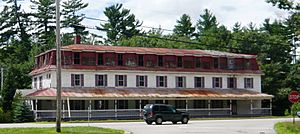Redstone, New Hampshire facts for kids
Quick facts for kids
Redstone, New Hampshire
|
|
|---|---|

Old boarding house for quarry workers
|
|
| Country | United States |
| State | New Hampshire |
| County | Carroll |
| Town | Conway |
| Elevation | 486 ft (148 m) |
| Time zone | UTC-5 (Eastern (EST)) |
| • Summer (DST) | UTC-4 (EDT) |
| Area code(s) | 603 |
| GNIS feature ID | 872558 |
Redstone is a small community in Conway, New Hampshire, in the United States. It's located near Rattlesnake Mountain. From the late 1800s until about 1950, Redstone was famous for its "red" granite quarry. This quarry was a very important part of the area's history.
Contents
History of Redstone
Early Roads and Rattlesnakes
The first road through Redstone was built between 1765 and 1766. In the early days, people collected rattlesnakes from the nearby hills. The snakes' venom was thought to have medicinal uses. This is why the mountain was named Rattlesnake Mountain.
However, a big fire in the 1870s changed everything. The fire killed the rattlesnakes and left the rocky slopes bare. This made the land ready for a new industry: granite mining. New Hampshire is even known as the "Granite State" because of its many quarries.
Discovering Redstone Granite
The quarries in Conway, including those near Redstone, produced a type of granite used for building. This granite came in different colors, like pinkish-red and dark greenish-grey. The finer granite was polished for monuments, while coarser types were used for buildings, bridges, and paving.
The Railroad Arrives
The Portland and Ogdensburg Railroad built train tracks through Redstone in 1865. Later, the Maine Central railroad took over. The Redstone train stop was created after the quarry became very active.
The quarry started getting big orders for stone in the late 1870s. This included stone for three bridges. The quality of Redstone's granite caught the eye of George W. Wagg, a railroad official. Soon, the Maine and New Hampshire Granite Company began using Redstone granite.
A Growing Community
A train station was built in Redstone in 1888, and a post office opened the next year. There was also a small church for the quarry workers. Many workers lived in special housing or a large boarding house called "the Schooner." This boarding house could hold 80 men.
By 1889, about 300 men worked at the Redstone quarry. They shipped out many train cars full of granite every day. The quarry had over twenty derricks, which are machines used to lift heavy things. Huge slabs of red, pink, or green granite were loaded directly onto Boston & Maine Railroad cars. The growth of the quarry and the railroad went hand-in-hand. Many new train stations were even built using Redstone granite.
New Hampshire's Granite Industry
New Hampshire has used granite for building since 1623. The value of granite mined in the state grew a lot. In 1902, New Hampshire was the fourth-largest granite producer in the United States. The granite was used for buildings, monuments, and paving.
Exploring the Old Quarry Today
Hiking to the Quarry Site
The Redstone quarry officially closed in 1942. Today, the granite area is protected by The Nature Conservancy. This was made possible by a gift from Anna B. Stearns in 1990, which helped create the Green Hills Preserve.
You can now hike a trail that leads along a ridge. This trail offers great views of the White Mountains. The trail ends at the site of the old quarry, where you can see where all that famous granite was once mined.




